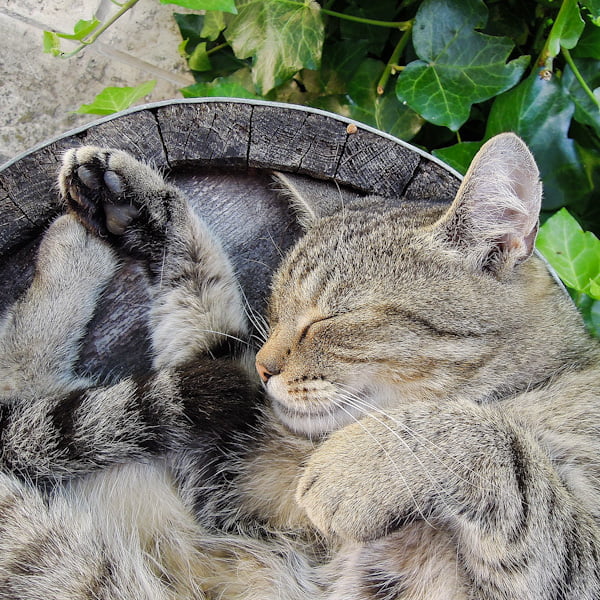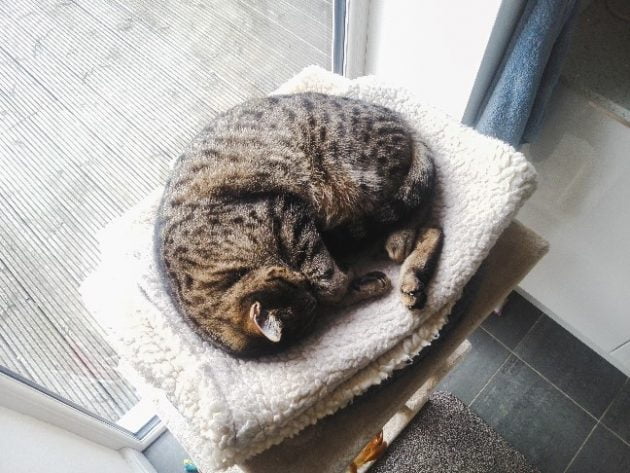Domestic cats are polyphasic sleepers. Humans normally engage in monophasic sleep – sleeping once at night for about 8 hours. Sometimes humans sleep in 2 periods over the course of 24 hours: once at night and once at siesta. This is biphasic sleep. The word “biphasic” means in two phases. Polyphasic means in many phases (‘poly’ meaning many and ‘phasic’ meaning phases).
Human sleep patterns
Not all humans engage in monphasic sleep. Sometimes their sleep is broken down into 2 phases as mentioned or they might have several naps during the day. This certainly occurs in older people. So people are not necessarily always monophasic. Boris Johnson, the UK’s prime minister enjoys a power nap during the day. This means that he is a biphasic sleeper if he adds this to his nighttime sleep.
The reason why most people have a monophasic sleep pattern is because of conventional work practices; sleep during the night and work during the daytime. But a large section of society don’t adhere to this convention. Retired people of which there is a growing number, are probably better described as polyphasic sleepers or at least biphasic.

Domestic cats are polyphasic sleepers
But domestic cats are polyphasic. It is thought that humans might have been polyphasic and I don’t think that our sleep behavior is set in concrete. It’s up for grabs as long as we get our sleep efficiently and effectively.
It suits the cat to be polyphasic because of their innate lifestyle and their modified lifestyle living with humans. This raises an issue that I want to address in this article: cats give the impression to people that they sleep all the time because they have a different sleep pattern to ours. Polyphasic sleeping might give the impression to the human observer that they are sleeping for very long period of time. It simply isn’t true.
Deep sleep as a percentage of overal sleep
It should also be said that during these polyphasic naps cats are not in deep REM sleep the whole time. Part of this time they are snoozing and drifting into deeper sleep. And part of the time they are sleeping and dreaming. I would suggest, from observating my cat, that if he “sleeps” on my lap for about an hour, during this time he may enjoy proper deep sleep for about 15-20 minutes. This is about 25% to 33% of the time.
Study on lab cats
A study conducted on laboratory cats (I hate that phrase) indicated that they had a cycle duration of 104 minutes. There were 24 minutes of wakefulness and 79 minutes of sleep. During the sleep episodes there are about 2.5 episodes of deep sleep. The study does not explain what was going on in terms of the cats’ routines but I’d suggest that as they were laboratory cats they had nothing to do and therefore spent most of their time snoozing and deep sleeping with periods of low-level activity.

Full-time indoor cats
The life of a laboratory cat may reflect in some respects the life of a full-time indoor cat in a home where they are not entertained. If a domestic is confined to, let’s say, a small home or an apartment and their owner goes out to work every day, the cat will behave much like those laboratory cats. They will snooze through the day in a polyphasic way. This gives the impression that domestic cats enjoy a lot of sleep and need a lot of sleep. This is not true in my view. They’re just killing time.
Why are domestic cats polyphasic sleepers?
Domestic cats are probably polyphasic sleepers because they’re programmed to hunt at any time during the 24-hour cycle. Although, we all know by now that they tend to focus on dawn and dusk activity i.e. crepuscular activity as prey is more available at these times. However, this is not set in concrete. They will hunt during the day and during nighttime. It’s a very fluid lifestyle in terms of activity levels and rest times.
This fluidity in their lifestyle results in polyphasic sleep. And their polyphasic sleep pattern can mislead humans into believing that cats sleep for upwards of 18 hours per day. It is time that this myth is scotched. The truth is that domestic cats sleep – by which I mean genuinely sleep rather than snoozing – for a similar period of time to people.

Comment please
If you disagree with me on this then please leave me a comment as I would like to hear from you. I’ve not seen a discussion on feline polyphasic sleep patterns and how it can fool people into believing that they sleep all the time.
Study referred to: The polycyclic sleep-wake cycle in the cat: Effects produced by sensorimotor rhythm conditioning.

